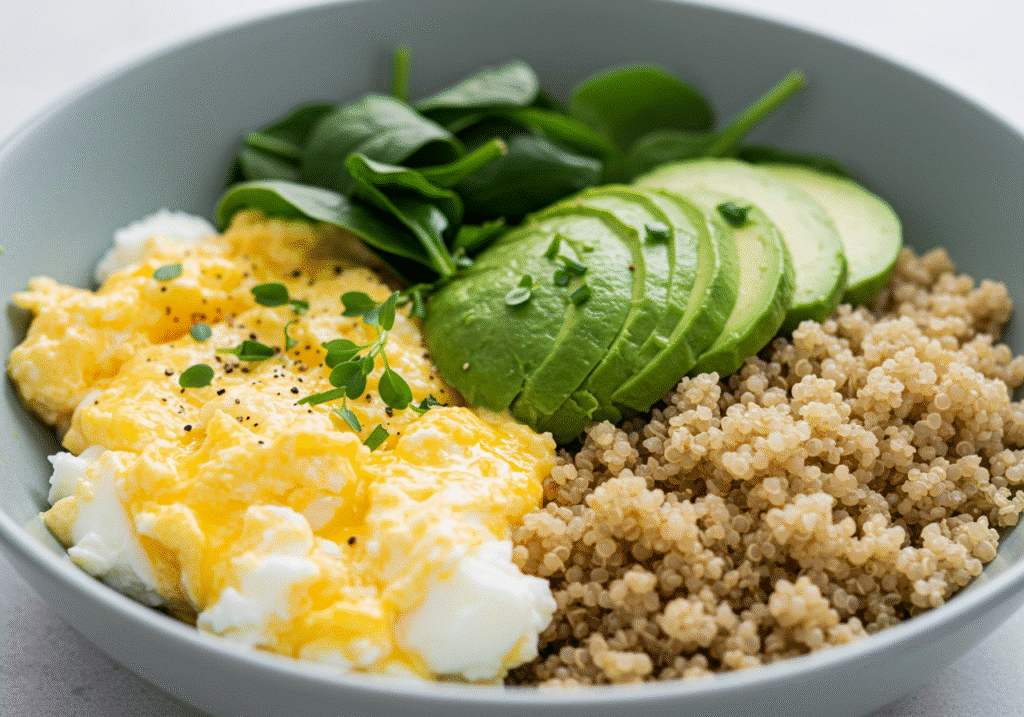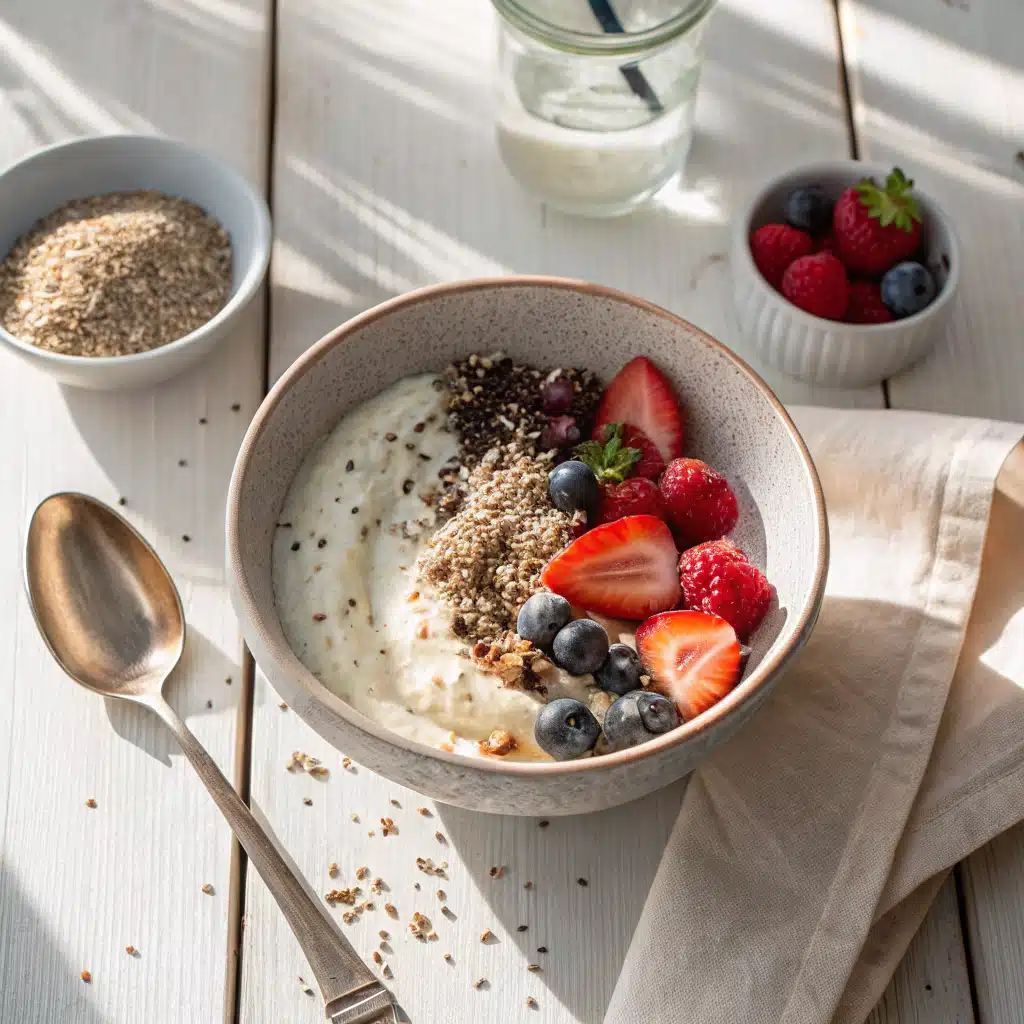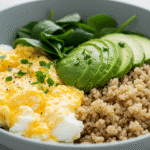A healthy breakfast can make all the difference in the world, especially if it’s high in protein. More than just a fad high protein breakfast bowls are the key to staying full alert and focused throughout the morning. The correct mix of ingredients in a bowl can do wonders, whether your goal is to lose weight, gain muscle or just avoid that mid-morning crash.
Everything you need to know about making wholesome and delectable high-protein breakfast bowls will be covered in this post from the science of protein to detailed recipes and preparation advice. Expert responses to frequently asked questions such as how to consume 30g or even 50g of protein in a single breakfast are also available.

Table of Content
High Protein Breakfast Bowls
Why High Protein Breakfast Bowls Are a Game-Changer
Understanding the Role of Protein in Breakfast
Protein is crucial for maintaining and building muscle, supporting metabolic function and keeping you full for longer. Unlike carbs that are quickly burned, protein takes longer to digest. This slower digestion not only sustains your energy levels throughout the morning but also helps regulate blood sugar spikes and crashes.
According to studies from the American Journal of Clinical Nutrition high protein breakfasts reduce hunger hormones and increase feelings of fullness. That means fewer cravings before lunch and improved calorie control throughout the day.
In a world where quick breakfasts often mean sugary cereals and processed pastries high protein breakfast bowls offer a more balanced, nutrient-dense option.
Benefits of Starting Your Day with a Protein-Packed Bowl
- Sustained Energy Levels
Protein stabilizes blood sugar and prevents the “crash” effect that many feel after a high-carb breakfast. It keeps your brain and body fueled until your next meal. - Supports Weight Management
Consuming protein in the morning boosts your metabolism through the thermic effect of food. Your body burns more calories digesting protein compared to carbs or fats. - Improves Focus and Brain Function
Amino acids from protein support neurotransmitters like dopamine and serotonin, both of which play key roles in focus and mood. - Perfect for Muscle Maintenance & Growth
Whether you’re working out or just staying active, protein in the morning helps preserve lean muscle mass and supports post-workout recovery. - Reduces Unhealthy Snacking
Starting your day with protein keeps hunger in check, reducing the urge for sugary snacks and drinks before lunch.
Nutritional Science Behind High Protein Breakfasts
Macronutrient Breakdown of a Balanced Bowl
A successful high protein breakfast bowl isn’t just about piling on protein it’s about balance. Your body thrives when it receives the right mix of macronutrients: protein, carbohydrates and healthy fats Here’s what your ideal breakfast bowl should look like:
| Macronutrient | % of Calories | Sources in Breakfast Bowls |
|---|---|---|
| Protein | 30–40% | Eggs, turkey sausage, tofu, Greek yogurt |
| Carbohydrates | 30–40% | Quinoa, oats, sweet potatoes, fruits |
| Fats | 20–30% | Avocados, nuts, seeds, olive oil |
Focusing on this ratio helps maintain energy, reduces cravings and promotes muscle health especially important for active individuals or those trying to lose fat without losing lean mass.
Including fiber-rich carbs (like oats or sweet potatoes) and unsaturated fats (like almonds or chia seeds) ensures long-lasting satiety and stable blood sugar levels.
Protein Quality and Absorption in Breakfast Foods
Not all proteins are created equal. The bioavailability (how well your body absorbs and uses a nutrient) of protein varies depending on the source. Here’s a quick breakdown:
| Protein Source | Type | Bioavailability Score |
|---|---|---|
| Egg Whites | Animal | 100 (reference standard) |
| Whey Protein | Animal/Dairy | 104 (highly absorbable) |
| Chicken/Turkey | Animal | 79–89 |
| Greek Yogurt | Animal/Dairy | 84 |
| Soy/Tofu | Plant | 74 |
| Lentils/Chickpeas | Plant | 49–55 |
Combining different protein types like pairing eggs with black beans or Greek yogurt with chia seeds enhances amino acid availability, especially for vegetarians or vegans.
Complete proteins (which include all 9 essential amino acids) come from animal sources or smart combinations of plant foods like rice + beans or tofu + whole grains.
Additionally protein absorption is influenced by:
- Cooking methods (e.g. lightly scrambled eggs retain more protein integrity than overcooked ones)
- Fiber presence (too much fiber may slow protein uptake)
- Meal timing (eating protein consistently across meals improves muscle retention and metabolism)
Top Ingredients for High Protein Breakfast Bowls
Choosing the right ingredients is key to making your high protein breakfast bowls both delicious and nutritionally powerful. Whether you’re a meat-eater, vegetarian, or following a plant-based diet, there are plenty of protein-rich options to help you start strong.
Animal-Based Protein Sources: Eggs, Turkey, Greek Yogurt
If you’re including animal products in your breakfast these ingredients offer high protein density and excellent bioavailability:
1. Eggs (6g protein per egg)
Eggs are a gold-standard breakfast food. They’re quick to cook and contain all nine essential amino acids. Scrambled, poached, or boiled they’re perfect in nearly any bowl.
2. Egg Whites (3.6g per white)
Lower in fat and calories than whole eggs but still high in protein, egg whites are ideal if you’re watching cholesterol or calories.
3. Greek Yogurt (15–20g per cup)
Thick creamy and packed with protein. Use plain, non-fat Greek yogurt as a base and build your bowl from there with fruit, oats, or nuts.
4. Cottage Cheese (14g per ½ cup)
A surprisingly versatile ingredient, cottage cheese blends well into savory or sweet bowls.
5. Turkey Sausage or Lean Chicken (15–20g per 3 oz)
For a hearty savory bowl, cooked turkey sausage or grilled chicken strips bring plenty of protein without excessive fat.

Plant-Based Options: Tofu, Tempeh, Chickpeas and More
You don’t need meat to make your bowl protein-rich. Plant-based eaters can craft equally powerful meals with these options:
1. Tofu (10g per ½ cup)
Firm or extra-firm tofu absorbs flavors well. Pan-fry or scramble it with veggies for a satisfying, savory bowl.
2. Tempeh (16g per 3 oz)
Made from fermented soybeans, tempeh offers more protein and a firmer texture than tofu great for grilled or sautéed bowls.
3. Chickpeas (7g per ½ cup)
Add roasted or spiced chickpeas for crunch and fiber. They’re an easy way to boost protein and texture.
4. Lentils (9g per ½ cup cooked)
Hearty, earthy and filling lentils work beautifully in breakfast grain bowls alongside greens and avocado.
5. Vegan Protein Powder (15–25g per scoop)
A convenient way to increase protein in smoothie bowls. Choose clean low-sugar options made from pea or rice protein.
6. Nutritional Yeast (4g per 2 tbsp)
This cheesy-flavored superfood boosts protein and B12 in plant-based bowls.
Healthy Add-ins to Boost Protein Further
- Chia seeds (5g per 2 tbsp) – Add to yogurt or overnight oats
- Hemp seeds (10g per 3 tbsp) – Nutty and nutrient-dense
- Quinoa (8g per cooked cup) – A complete protein grain
- Pumpkin seeds (7g per ¼ cup) – Great for crunch and flavor
How to Make a High Protein Breakfast Bowl (Step-by-Step Guide)
Creating the perfect high protein breakfast bowl is like building a layered masterpiece balanced, satisfying, and tailored to your taste. Whether you’re rushing out the door or taking time to cook, following a simple structure ensures you hit your nutritional goals while keeping things delicious.
Essential Components: Grains, Protein, Healthy Fats, and Fiber
Here’s a simple formula that works for nearly any bowl:
Base + Protein + Healthy Fat + Fiber + Flavor Add-ons = Perfect Breakfast Bowl
| Component | Examples | Nutritional Role |
|---|---|---|
| Base | Quinoa, oats, farro, brown rice | Energy from complex carbs |
| Protein | Eggs, tofu, turkey, Greek yogurt | Builds muscle, keeps you full |
| Healthy Fats | Avocado, nuts, seeds, nut butter | Brain function, satiety |
| Fiber | Berries, greens, sweet potato | Digestion, blood sugar control |
| Flavor | Spices, herbs, sauces, lemon juice | Keeps meals exciting without sugar |
When designing your bowl, aim for at least 20–30g of protein. Use lean meats or plant proteins paired with whole grains and fiber-rich ingredients.
Recipe Template for Customizable Breakfast Bowls
Here’s a plug-and-play guide to creating endless bowl variations:
Step 1: Choose Your Base (½ – 1 cup cooked)
- Cooked quinoa
- Rolled oats (or overnight oats)
- Brown rice
- Sweet potatoes (cubed or mashed)
Step 2: Add Your Protein (20–30g target)
- 2–3 scrambled eggs
- ½ cup cottage cheese
- 1 scoop protein powder in oats or yogurt
- ½ cup cooked tofu or tempeh
- ¾ cup Greek yogurt
Step 3: Include Healthy Fats
- ¼ avocado sliced
- 1 tbsp almond or peanut butter
- 1 tbsp chia or hemp seeds
- Drizzle of olive oil (for savory bowls)
Step 4: Add Fruits or Veggies (fiber + micronutrients)
- Berries, bananas or chopped apples for sweet bowls
- Spinach, kale, tomatoes, bell peppers for savory options
Step 5: Flavor & Texture Enhancers
- Dash of cinnamon or nutmeg (for sweet)
- Pinch of turmeric, cumin, paprika (for savory)
- Lemon juice, salsa or tahini drizzle
Smart Tips for Better Bowls
- Meal prep your bases: Cook a batch of quinoa or oats to save time.
- Pre-cook proteins: Hard-boil eggs, bake tofu or prep turkey sausage on Sundays.
- Use layered containers: Keep wet and dry ingredients separate if prepping ahead.
- Switch between sweet and savory to avoid flavor fatigue.
With this framework you can craft a bowl that’s fast, filling and full of muscle-building power.
5 Delicious High Protein Breakfast Bowl Recipes
From savory to sweet plant-based to meat-lover friendly high protein breakfast bowls can be tailored to every lifestyle. Below are five power-packed recipes you can rotate through your week to stay energized and full without sacrificing flavor.
1. Savory Spinach & Turkey Sausage Bowl
Protein: ~34g | Prep Time: 15 mins
Ingredients:
- 2 scrambled eggs (12g)
- 3 oz turkey sausage, sliced (18g)
- ½ cup cooked quinoa (4g)
- 1 cup sautéed spinach
- ½ avocado
- Sprinkle of shredded cheese (optional)
Instructions:
Cook turkey sausage and set aside. Scramble the eggs then sauté the spinach lightly in olive oil. Layer quinoa as the base, add sausage, eggs, spinach, and avocado slices. Top with cheese or hot sauce if desired.
2. Greek Yogurt & Quinoa Energy Bowl

Protein: ~30g | Prep Time: 10 mins
Ingredients:
- ¾ cup non-fat Greek yogurt (15g)
- ½ cup cooked quinoa (4g)
- 1 scoop unflavored whey protein (10g)
- ½ cup fresh berries
- 1 tbsp chia seeds (5g)
Instructions:
In a bowl mix protein powder into yogurt until smooth. Add quinoa, berries and sprinkle with chia seeds. Drizzle with honey or maple syrup if you like it sweeter.
3. Tofu Scramble & Avocado Bowl (Vegan)
Protein: ~29g | Prep Time: 20 mins
Ingredients:
- ½ block firm tofu, crumbled (18g)
- ½ cup cooked black beans (7g)
- ½ avocado, sliced
- ¼ cup sautéed onions & bell peppers
- ½ cup cooked brown rice
- Spices: turmeric, cumin, garlic powder
Instructions:
Sauté tofu with spices until slightly browned. Add black beans and vegetables. Serve over brown rice with avocado on top.
4. Egg White & Black Bean Southwestern Bowl
Protein: ~31g | Prep Time: 15 mins
Ingredients:
- 4 egg whites (14g)
- ½ cup cooked black beans (7g)
- ¼ cup shredded cheddar (6g)
- ½ cup cooked brown rice or farro (4g)
- Fresh salsa and cilantro
Instructions:
Scramble egg whites with a pinch of pepper. Layer over brown rice, add black beans, cheese and top with salsa and cilantro.
5. Chia Pudding and Protein Granola Bowl (No-Cook)
Protein: ~28g | Prep Time: Overnight
Ingredients:
- 3 tbsp chia seeds soaked in 1 cup almond milk overnight (10g)
- ½ cup protein granola (12g)
- ½ cup Greek yogurt (8g)
- ¼ banana sliced
- 1 tbsp almond butter
Instructions:
In the morning, stir the chia pudding, top with granola, yogurt, banana and almond butter. A quick grab-and-go bowl with solid protein and fiber.
How to Get 30g to 50g of Protein in One Breakfast
One of the most common breakfast goals for fitness lovers, weight-watchers or busy professionals is hitting that 30g or even 50g protein mark without chugging chalky shakes or eating six eggs. The good news? It’s absolutely doable with smart planning and whole foods.
Meal Combinations to Hit 30g Protein
Here are five realistic combinations using everyday ingredients that bring you right around the 30g protein target perfect for sustaining energy through the morning.
| Meal Option | Protein Source | Protein (approx.) |
|---|---|---|
| Greek Yogurt Bowl + Chia + Almond Butter | Greek yogurt (¾ cup), chia seeds, 1 tbsp nut butter | 30g |
| Egg Bowl + Turkey Sausage + Avocado | 2 eggs, 3 oz turkey sausage, ½ avocado | 33g |
| Protein Oatmeal + Seeds | ½ cup oats, 1 scoop protein powder, 1 tbsp hemp seeds | 32g |
| Tofu Scramble + Black Beans | ½ block tofu, ½ cup black beans | 28–30g |
| Overnight Oats + Cottage Cheese | ½ cup cottage cheese + ½ cup oats + peanut butter | 30g |
Advanced Tips to Reach 50g Without Shakes
Want to push toward the 50g protein level? Here’s how to do it by stacking proteins within your bowl while maintaining flavor and balance.
Strategy 1: Double Your Base Protein
- Instead of one egg use two whole eggs and add two egg whites. That’s 18g protein right there.
- Add 3 oz turkey sausage for 18g more.
- Toss in 1 tbsp hemp seeds for another 3g.
- Finish with ½ cup cooked quinoa (4g) and a sprinkle of cheese (5g).
➡ Total Protein: 48–50g
Strategy 2: Layer Plant-Based Proteins
- Start with ½ cup tofu (10g)
- Add ½ cup lentils (9g) and ½ cup black beans (7g)
- Mix in 3 tbsp hemp seeds (10g)
- Top with 1 tbsp peanut butter (4g)
➡ Total Protein: 40–45g
Add 1 scoop vegan protein powder into a smoothie base or chia pudding on the side to cross the 50g mark.
Strategy 3: Supplement Naturally
Instead of protein powders use high-protein ingredients that naturally elevate your totals:
- Cottage cheese (14g per ½ cup)
- Edamame (9g per ½ cup)
- Protein-rich granolas (10g per ½ cup)
Pair two or more of these with your bowl and you’re well on your way to high protein success no blender required.
Best High Protein Foods to Add in Breakfast Bowls
When it comes to building effective and tasty high protein breakfast bowls it’s all about stocking your kitchen with the right foods. Some protein sources are obvious, while others fly under the radar. In this section we’re highlighting the best of both so your bowl is never boring and always packed with muscle-building fuel.
Top 10 High Protein Add-ins for Every Diet
These ingredients are perfect to mix, match and layer into any kind of breakfast bowl sweet or savory.
| Ingredient | Serving | Protein |
|---|---|---|
| Greek Yogurt | ¾ cup | 15–20g |
| Eggs (whole) | 2 eggs | 12g |
| Egg Whites | 4 whites | 14g |
| Cottage Cheese | ½ cup | 14g |
| Turkey Sausage | 3 oz | 18g |
| Tofu | ½ cup | 10g |
| Tempeh | 3 oz | 16g |
| Black Beans | ½ cup | 7g |
| Quinoa (cooked) | 1 cup | 8g |
| Hemp Seeds | 3 tbsp | 10g |
These all pair beautifully with grains, fruits, vegetables and sauces making them ideal anchors for a high-protein breakfast.
Surprising Protein Boosters You’re Probably Missing
Want to level up your protein game without adding more eggs or meat? These clever add-ins deliver stealthy protein and great texture:
1. Nutritional Yeast
- 2 tablespoons = 4g protein
- Cheesy, nutty and perfect for savory bowls especially vegan ones.
2. Peanut Butter Powder
- 2 tablespoons = 8g protein
- All the flavor of peanut butter with less fat and calories. Great in oatmeal or yogurt.
3. Edamame
- ½ cup cooked = 9g protein
- Toss them into grain bowls or blend into spreads.
4. Protein Granola
- ½ cup = 10–12g protein
- Look for brands with pea or soy protein for a crunchy, satisfying breakfast layer.
5. Pumpkin Seeds
- ¼ cup = 7g protein
- Toasted and sprinkled on top of any bowl for a boost of zinc, magnesium, and protein.
6. Almond Flour
- ¼ cup = 6g protein
- Mix into oatmeal or smoothies for added protein and healthy fats.
Storage, Prep and Make-Ahead Tips
One of the best things about high protein breakfast bowls is that they’re incredibly meal prep-friendly. With just one prep session each week you can have grab-and-go meals ready for busy mornings without compromising on protein or flavor.
Here’s how to plan, prep and store your breakfast bowls the smart way.
How to Prep Bowls for the Week (Meal Prep Tips)
Prepping in advance not only saves time but also keeps you consistent with your nutrition goals. Use these strategies:
Batch Cook Your Bases
Cook large portions of
- Quinoa, brown rice, or oats (store in airtight containers)
- Roasted veggies like sweet potatoes, bell peppers or zucchini
- Protein options like grilled chicken, boiled eggs or tofu
Use a Compartment Method
To avoid soggy textures or flavor clashes, prep bowls in components
- Keep wet and dry ingredients separate
- Layer proteins and bases in one section
- Store toppings (nuts, seeds, fruit) in small side containers
Mix and Match Combos
Prep 3–4 proteins and 2–3 bases then rotate ingredients to create new combinations each day.
| Day | Protein | Base | Add-Ons |
|---|---|---|---|
| Mon | Greek yogurt | Oats | Berries, chia |
| Tue | Eggs + turkey | Quinoa | Spinach, feta |
| Wed | Tofu | Rice | Avocado, black beans |
| Thu | Cottage cheese | Granola | Banana, almond butter |
| Fri | Lentils + tempeh | Farro | Arugula, hummus |
Safe Storage and Reheating Practices
Proper storage ensures your protein sources stay fresh and food-safe.
Storage Guidelines:
| Item | Fridge Life | Freezer Life |
|---|---|---|
| Cooked quinoa, rice | 4–5 days | 1 month |
| Scrambled eggs | 3–4 days | Not recommended |
| Tofu or tempeh | 5 days (sealed) | 1–2 months |
| Greek yogurt | Up to 7 days | Not suitable |
| Roasted veggies | 4 days | 1–2 months |
Reheating Tips:
- Microwave bowls with a splash of water or broth to keep them moist
- Reheat eggs and meat separately if possible
- Cold bowls (like yogurt or chia) should be assembled fresh for best texture
Common Mistakes to Avoid in High Protein Breakfasts
Even the most nutrient-packed high protein breakfast bowls can fall short if not planned carefully. Below are the most common missteps people make and how you can avoid them for the best flavor, balance and results.
Skimping on Fiber and Healthy Fats
One of the biggest mistakes is focusing too heavily on protein while ignoring fiber and healthy fats. This imbalance can lead to:
- Digestive sluggishness
- Cravings before lunch
- Poor blood sugar control
Example:
A bowl with just egg whites and turkey may deliver protein but without fiber (e.g., veggies, whole grains) and healthy fats (e.g., avocado, seeds) it won’t keep you satisfied.
Fix:
Balance is key. Add ½ avocado, 1 tbsp chia seeds or ½ cup veggies to round out your bowl.
Over-relying on Protein Powders
Protein powders can be convenient but they shouldn’t dominate your breakfast. Many are highly processed, contain artificial additives and lack the satiety of whole foods.
Problem:
- Upset stomach
- Artificial taste
- Limited micronutrients
Fix:
Use powders as a boost not a base. Blend them into oats or yogurt rather than replacing whole food sources.
Missing Out on Variety
Eating the same bowl every day can lead to taste fatigue and nutritional gaps.
Fix:
- Rotate between plant-based and animal proteins
- Try different grains like farro, bulgur or barley
- Swap toppings seasonally berries in summer, roasted squash in fall
Forgetting About Micronutrients
Focusing only on macros (protein, carbs, fats) and forgetting about vitamins and minerals can limit your bowl’s true power.
Fix:
- Include leafy greens, bell peppers, berries and seeds regularly
- Sprinkle nutritional yeast for B12 and a cheesy flavor
- Add herbs like parsley or cilantro for detox support
FAQs About High Protein Breakfast Bowls
What is the highest protein food for breakfast?
The highest protein foods for breakfast include egg whites, Greek yogurt and lean meats like turkey sausage or chicken breast. One cup of non-fat Greek yogurt contains up to 20 grams of protein while a 3-ounce serving of turkey sausage provides 18–20 grams. Plant-based options like tempeh and tofu also deliver 10–16 grams of protein per serving.
To maximize protein intake, build high protein breakfast bowls using a combination of these foods with fiber-rich carbs and healthy fats.
How can I get 30g of protein for breakfast?
You can easily hit 30 grams of protein at breakfast by combining two or three high-protein foods. Here are a few example meals:
2 eggs + 3 egg whites + 2 slices turkey bacon
¾ cup Greek yogurt + 1 scoop protein powder + 1 tbsp chia seeds
½ cup tofu + ½ cup lentils + 2 tbsp hemp seeds
The key is to layer your proteins smartly using both whole foods and a few targeted add-ins in your breakfast bowl.
How to make a high-protein breakfast bowl?
To build a satisfying high protein breakfast bowl, follow this step-by-step formula:
Choose a base: oats, quinoa or sweet potatoes
Add protein: eggs, tofu, Greek yogurt or lean meat
Include healthy fats: avocado, seeds or nut butter
Top with fiber-rich produce: leafy greens, berries or beans
Flavor it: with herbs, spices or sauces
This simple structure allows you to customize based on taste or diet and still get 25–35g of protein in a single serving.
How can I eat 50 grams of protein for breakfast?
To reach 50 grams of protein at breakfast without relying solely on shakes, combine multiple sources:
3 eggs + 3 oz turkey sausage + 1 tbsp hemp seeds + ½ cup quinoa
1 scoop protein powder mixed into oatmeal + ¾ cup Greek yogurt + 2 tbsp almond butter
½ block tofu + ½ cup chickpeas + 3 tbsp hemp seeds + nutritional yeast
You can also enjoy a smoothie bowl alongside your main dish, layered with seeds and protein granola to add another 10–15 grams of protein.

Savory Spinach & Turkey Sausage Breakfast Bowl
- Total Time: 25 minutes
- Yield: 1 serving 1x
Description
Fuel your morning with this hearty and healthy breakfast bowl! Packed with protein-rich turkey sausage, fluffy scrambled eggs, quinoa, fresh spinach and creamy avocado this savory combo is both satisfying and energizing.
Ingredients
-
2 eggs
-
3 oz turkey sausage
-
½ cup quinoa
-
1 cup spinach
-
½ avocado
Instructions
-
Cook sausage and set aside.
-
Scramble eggs and sauté spinach.
-
Layer quinoa, sausage, eggs, spinach, and avocado in a bowl.
-
Add salt, pepper, or hot sauce as desired.
Notes
-
Use pre-cooked quinoa for a faster prep.
-
Add extra veggies like cherry tomatoes or bell peppers for color and nutrients.
-
Swap turkey sausage for chicken sausage or tofu for variation.
- Prep Time: 15 minutes
- Cook Time: 10 minutes
- Category: Breakfast
- Method: Stovetop
- Cuisine: American
Nutrition
- Serving Size: 1
- Calories: ~420 kcal
- Sugar: ~1g
- Sodium: ~480mg
- Fat: ~24g
- Saturated Fat: ~5g
- Unsaturated Fat: ~18g
- Trans Fat: 0g
- Carbohydrates: ~14g
- Fiber: ~4g
- Protein: 34g
- Cholesterol: ~380mg

